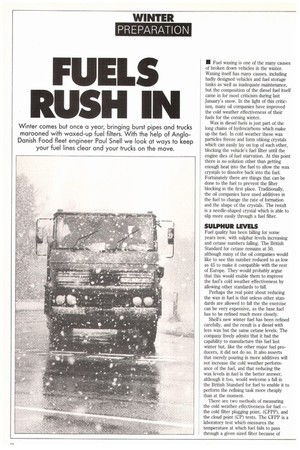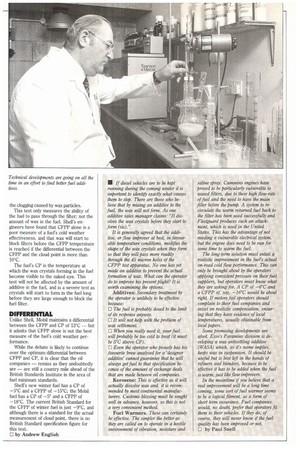FUELS RUSH I
Page 68

Page 69

If you've noticed an error in this article please click here to report it so we can fix it.
• Fuel waxing is one of the many causes of broken down vehicles in the winter. Waxing itself has many causes, including badly designed vehicles and fuel storage tanks as well as inadequate maintenance, but the composition of the diesel fuel itself came in for most criticism during last January's snow. In the light of this criticism, many oil companies have improved the cold weather effectiveness of their fuels for the coming winter.
Wax in diesel fuels is just part of the long chains of hydrocarbons which make up the fuel. In cold weather these wax particles freeze and form oblong crystals which can easily lay on top of each other, blocking the vehicle's fuel filter until the engine dies of fuel starvation. At this point there is no solution other than getting enough heat into the fuel to allow the wax crystals to dissolve back into the fuel. Fortunately there are things that can be done to the fuel to prevent the filter blocking in the first place. Traditionally, the oil companies have used additives in the fuel to change the rate of formation and the shape of the crystals. The result is a needle-shaped crystal which is able to slip more easily through a fuel filter.
SULPHUR LEVELS
Fuel quality has been falling for some years now, with sulphur levels increasing and cetane numbers falling. The British Standard for cetane remains at 50, although many of the oil companies would like to see this number reduced to as low as 45 to make it compatible with the rest of Europe. They would probably argue that this would enable them to improve the fuel's cold weather effectiveness by allowing other standards to fall.
Perhaps the real point about reducing the wax in fuel is that unless other standards are allowed to fall the the exercise can be very expensive, as the base fuel has to be refined much more closely.
Shell's new winter fuel has been refined carefully, and the result is a diesel with less wax but the same cetane levels. The company freely admits that it had the capability to manufacture this fuel last winter but, like the other major fuel producers, it did not do so. It also asserts that merely pouring in more additives will not increase the cold weather performance of the fuel, and that reducing the wax levels in fuel is the better answer, although it too, would welcome a fall in the British Standard for fuel to enable it to perform the refining task more cheaply than at the moment.
There are two methods of measuring the cold weather effectiveness for fuel — the cold filter plugging point, (CFPP), and the cloud point (CP) tests. The CFPP is a laboratory test which measures the temperature at which fuel fails to pass through a given sized filter because of the clogging caused by wax particles.
This test only measures the ability of the fuel to pass through the filter; not the amount of wax in the fuel. Shell's engineers have found that CFPP alone is a poor measure of a fuel's cold weather effectiveness, and that wax will start to block filters before the CFPP temperature is reached if the differential between the CFPP and the cloud point is more than 10°C.
The fuel's CP is the temperature at which the wax crystals forming in the fuel become visible to the naked eye. This test will not be affected by the amount of additive in the fuel, and is a severe test as crystals will start to form in the fuel long before they are large enough to block the fuel filter.
DIFFERENTIAL
Unlike Shell, Mobil maintains a differential between the CFPP and CP of 13°C — but it admits that CFPP alone is not the best measure of the fuel's cold weather performance.
While the debate is likely to continue over the optimum differential between CFPP and CP, it is clear that the oil companies — remiss as they undoubtedly are — are still a country mile ahead of the British Standards Institute in the area of fuel minimum standards.
Shell's new winter fuel has a CP of — 5°C and a CFPP of —15°C; the Mobil fuel has a CP of —5° and a CFPP of — 18°C. The current British Standard for the CFPP of winter fuel is just —9°C, and although there is a standard for the actual measurement of cloud point, there is no British Standard specification figure for this test.
0 by Andrew English
• If diesel vehicles are to be kept running during the coming winter it is important to identify exactly what causes them to stop. There are those who believe that by mixing an additive to the fuel, the wax will not form. As one additive sales manager claims: it disaloes the wax crystals before they stall to form (sic)."
It is generally agreed that the additive, or flow improver at best, in favourable temperature conditions, modifies the shape of the wax crystals when they form so that they will Pass more readily through the 45 micron holes of the CFPP test apparatus. No one has yet made an additive to prevent the actual formation of wax. What can the operator do to improve his present plight? It is worth examining the options.
Additives: Secondary treatment by the operator is unlikely to be effective because:
O The fuel is probably dosed to the limit of its response anyway.
El It will not help with the problem of wax settlement.
O When you really need it, your fuel will Probably be too cold to treat (it must be 5°C above CP).
Even the operator who piously has his favourite brew analysed for a 'designer additive' cannot guarantee that he will always get fuel to that specification because of the amount of exchange deals that are made between oil companies.
Kerosene: This is effective as it will actually dissolve wax and, it is recommended by most continental manufacturers. Customs blessing must be sought well in advance, however, so this is not a very convenient method.
Fuel Warmers. These can certainly be effective. The simpler the better as they are called on to operate in a hostile environment of vibration, moisture and
saline spray. Cummins engines have proved to be particularly vulnerable to waxed filters, due to their high flow-rate of fuel and the need to have the main filter before the pump. A system to recirculate the warm returned fuel back to the filter has been used successfully and Fleetguard produces such an attachment, which is used in the United States, This has the advantage of not needing a vulnerable electrical system, but the engine does need to be run for some time to warm the fuel.
The long-term solution must entail a realistic improvement in the fuel's actual on-road cold _flow performance. This can only be brought about by the operators applying consistent pressure on their fuel suppliers, but operators must know what they are asking for. A CP of —6°C and a CFPP of say, —16°C would be about right. If motors fail operators should complain to their fuel companies and insist on realistic compensation, ensuring that they have evidence of local temperatures, usually obtainable from local papers.
Some promising developments are afoot. Esso's Paramins division is developing a wax antisettling additive (WASA) which, as it's name implies, keeps wax in suspension. It should be useful but is best left in the hands of refiners and blenders, because to be effective it has to be added when the fuel is warm, just like flow improvers.
In the meantime if you believe that a real improvement will be a long time coming, some sort of fuel warmer seems to be a logical fitment, as a form of short term insurance. Fuel companies would, no doubt, prefer that operators fit them to their vehicles. If they do, of course, they will never know if the fuel quality has been improved or not. 0 by Paul Snell












































































































































































